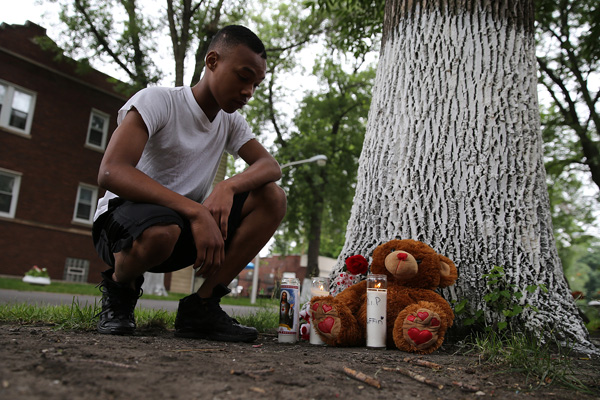
Photo: Antonio Perez: Chicago Tribune
Anthony Hardmon, 14, kneels beside his sister Ashley's memorial, Tuesday, July 3, 2013, near the intersection of Lamon and Kamerling Avenues where she was shot and killed, just one block from her home.
The good news about crime in Chicago is that, over a reasonable time frame of a couple decades, violent crime is down, substantially. And not because the city has gotten smaller. It's down on a per-capita basis as well. As Kevin Drum writes, "over the past two decades they're down by half or more. Occasional blips aside, Chicago is a lot safer than it was 20 years ago." It hasn't collapsed as it's done in New York, a phenomenon no one's really gotten to the bottom of, but it has declined substantially.
The bad news is that the profile of the typical Chicago homicide victim has gotten younger. Sadly, it's more of a youth problem than before. And a recent paper (via James Hamblin at The Atlantic) presented at the Society for Academic Emergency Medicine in Chicago and just published in Pediatrics shows how bad the problem is, in another Midwestern Rust Belt city: Flint.
Here's the scope of the problem in America that the paper is meant to address; even having written and read a lot about it, this number surprised me:
US firearm homicide rates are 19.5 times higher than other industrialized nations, with adolescent (15–24 years old) firearm homiciderates 42.7 times higher than children in 22 other developed nations.
In other words, the U.S. has a firearm-homicide problem, which everyone knows; that the problem is so much worse among youth manages to still be shocking. And youth violence is a very good predictor of further violence, and eventually mortality:
Sims et al found violently injured youth admitted to trauma units have readmission rates as high as 44% due to assault and 20% mortality due to homicide over a 5-year follow-up.
Those are remarkably high numbers, suggesting continued exposure to violence. Which makes the findings in the paper, a two-year study of emergency-department admissions (for assault injuries) in Flint, less surprising:
* 23 percent reported firearm possession in the past six months.
* 42 percent of those carried a gun outside the home.
* Of the 23 percent, the #1 response for why they had a gun was protection (37 percent)
* Half said it wouldn't be hard to get a gun; only 17 percent obtained their guns through legal means.
* More than half (57 percent) were the victim of assault in the six months previous or were threatened with a gun (59 percent).
It's a statistical look at how these things can spiral out of control, and why the readmission and mortality rates are so high: it doesn't take too many guns, and too many perceived threats, to eventually result in a homicide.



